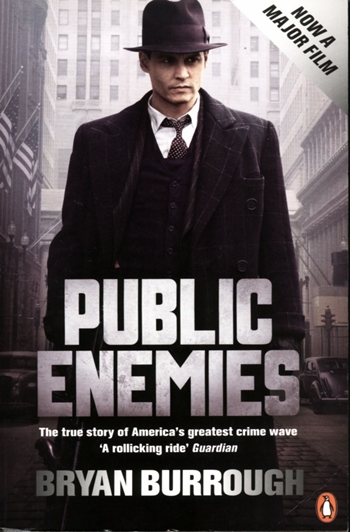
A quick glance through the Author’s Note at the beginning of this book quickly shows that the title of the book Public Enemies (ISBN 978-0-141-04258-9, Penguin Books, 2005) is erroneous. Despite the fact that the book does deal with some fairly well-known names in the American gangster era, such as Ma Barker, Bonnie and Clyde and John Dillinger, author Bryan Burrough states clearly, “This is the first comprehensive narrative history of the FBI’s War on Crime, which lasted from 1933 to 1936.” Whilst the wave of criminal behavior, which resulted from the Great Depression in the US, and the folk-lore criminals of the era made it necessary for there to be an FBI, this book deals more with J. Edgar Hoover and the agents of the FBI themselves than with the criminal Public Enemies of the time.
Whilst it is probably considered that the FBI is an organization that has carefully orchestrated methods of countering crime, stemming mostly from television dramas, this book will make you think otherwise. While J. Edgar Hoover was a stickler for punctuality, the FBI itself was chaotic and unconnected. Good information was relayed to operatives in the field, to be ignored by those higher up the tree.
The ineptitude of the criminals (for example “Machine Gun” Kelly’s wife boasted that her husband was a bank robber!) was only equaled (or even surpassed) by the ineptitude of the FBI officers in the field. Burrough’s book certainly leaves the reader in no doubt of that. “Losing (a criminal) was the kind of blunder the FBI made often in 1933 as Hoover’s men learned the ins and outs of professional law enforcement.”
Newspapers were able to show the FBI just where many of the criminals were headed, but the law enforcement officers were just as likely to lose the leads.
There are a few interesting photographic plates in the center of the book allowing the reader to put a face to the names. Ma Barker was certainly no beauty, and “Machine Gun” Kelly does not look like the gangster one imagines with such a nickname.
It is a very informative and fast-paced book, which has impeccable research to back up the narrative. In the Bibliographical Essay at the back of the book, before the Bibliographical Notes and the Index, Author Burrough states, “The primary source materials for this book are the FBI’s files on the War on Crime’s major cases, which have been released in bits and pieces since the mid 1980’s.” Burrough claims that he purchased several hundred thousand pages at 10 cents a page and has several filing cabinets full. I have no reason to doubt his claims. The book is very well researched, and if fond memories of the Bonnie and Clyde movie are with you, Bonnie was nowhere near as striking as Faye Dunaway, and as Burrough states, (the movie) “has taken a shark-eyed multiple murderer and his deluded girlfriend and transformed them into sympathetic characters, imbuing them with a cuddly likeability they did not possess, and a cultural significance they do not deserve.”
 |
 |
 |





